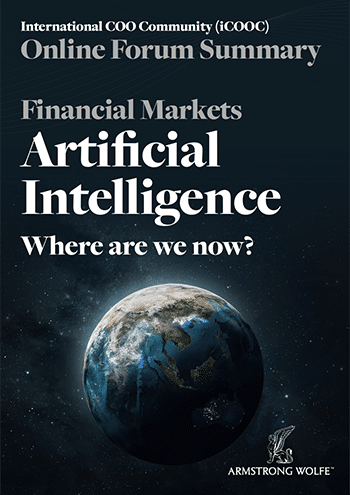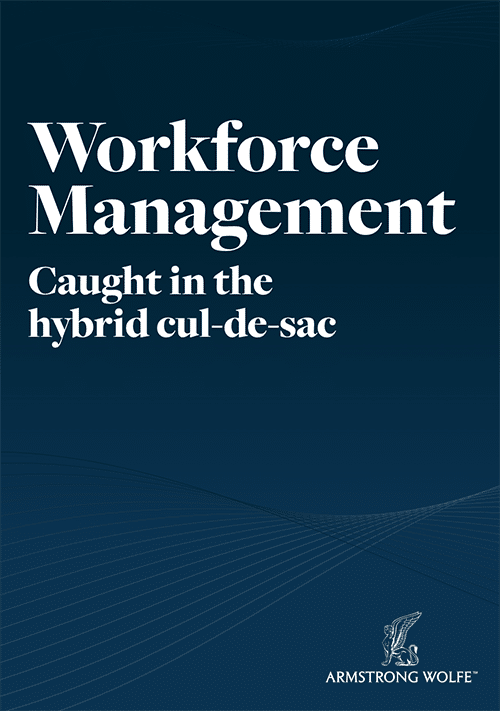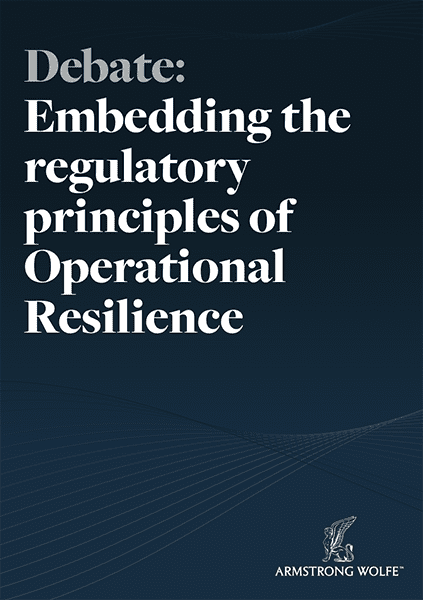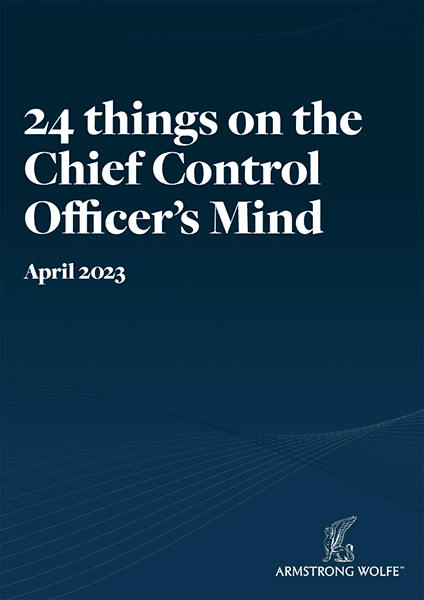“Having returned to a business role, do you think having been a COO will influence your ability to be successful in your career in the future?”
THE ACCIDENTAL COO
From business to business management
“Historically the COO role was used to help administrate and support the business, executing the strategy and aligning the organisation to ensure it achieved these objectives. This is how I saw it, but having become one I can see how the COO role can be more effectively used. Its position affords the business head a chance to allocate a greater diversification of tasks, empowering the role and, by doing so, effectively making it the de facto deputy chair to the business”
(COO hedge fund, previously equities business head)
When completing the series of papers for this book, it occurred to me that most, if not all, of its content and opinions had been captured, harvested and framed by the interaction with my primary sources, the COOs themselves. This is understandable, a natural direction for my research to take, aimed at pulling together a well versed narrative and argument, an informed insight to the role of the COO from those who live the role day to day, breathe its very existence and have mastered it to become successful in it.
However, despite the input from hundreds of information sources and countless number of conversations held on an ad hoc basis throughout the years and in the last twelve months, targeted and structured interviews, it felt something was missing. This quotation from a COO well known to me was the prompt, the moment that led to this reflection.
It firmed up my view that there needed to be some balance, a valued and respected outlook, an objective yet learned voice to offset the opinions of the COO, a voice that would hopefully complement their narrative. Otherwise, it could be argued that this series of papers was a narrow self-assessment, an insular consideration of what this band of brothers does and how COOs see themselves. At worst, a self-congratulatory play, a libretto reaffirming the complexities and demands of the role and a cry for those who underestimated it, to understand and appreciate it.
Who could offer this insight with the required and informed fairness? Who else than those who assess COOs’ performance, appraise them, rely upon them and in doing so are an authority on them. Those who have managed them and more so, those from this group who have been both a COO and have run a business using a COO. This managerial view was absent, being the assessment by those who had used and partnered a COO, it was their opinions that would make my assessment complete. I turned to one such contact and asked his initial thoughts on the subject, hoping his reply would support my thoughts:
“It’s a fundamentally different job than the one I had anticipated. There is a never-ending list of tasks, actions and decisions to be made. This level of diversity is matched only by the ever-changing priorities of the role and shifting timeframes. I often came into work with a well-planned and framed mindset to grapple with the tasks that lay ahead of me that day, for this plan to fall PRT almost as soon as I entered the office. I would immediately have to switch priorities to a new event of business criticality that had superseded and overrode all others. It is having this understanding that things change every day, that your COO never tells you 80% of what they are doing, that you appreciate once you have been in the role itself. It must be an ever-present temptation for a COO to want to tell their boss what they had been doing that day, that week or month, to allay any concerns that may be festering as to ‘what does my COO actually do to keep occupied daily?’ Plenty, I’d say, more than plenty, I can say that from experience.”
Another added:
“The effectiveness of the role is the holy trinity of the CEO to COO relationship, requiring the right person in the leadership role, giving the role its empowerment – a well-defined and constructed mandate, playing to both strengths and interests and the right person, with the right behavioural characteristics and aspirations in the COO role. Get these three right, and business as a whole will be the beneficiary of this well-honed and executed partnership. In turn, your effectiveness in the role rests on how you use the authority of your manager and how your manager has communicated he or she is happy for you to use their voice. People in the organisation need to understand and take on board when the COO calls, the call and the request or order have come from the CEO and, as such, need to be dealt with accordingly. This is an art in itself.”
Herein is a managerial group that would offer the necessary insight into how a COO role is perceived by those who directly rely on them. Linking in with this group would enable me to gather their thoughts as to what they think makes the COO role effective, thereafter to establish the profile of the person they require and from those who have been a COO and used one, what was discovered by taking this career path:
“Having been a COO and returning to a position running the business, I am now far better equipped and positioned to lead this business. Why? I had underestimated the diversity and volume of tasks addressed and managed by my COO. I have also become acutely aware of the demands and intricacies of the regulatory agenda and have been exposed to the full cost of running the business from front to back and, perhaps equally, the organisational challenges presented in getting things done and moving the change agenda forward. Having this knowledge makes me a better business head and allows me to carry the burden of regulatory responsibility more readily, more comfortably.”
This quotation is somebody who had been on the journey to be a COO and back into the business. We discussed his thoughts when he was presented the option of moving, not just from running a desk to being a COO, but a move organisationally from one bank to another, from a principal U.S. investment bank to a U.K. bank:
“It wasn’t a move I had thought about until presented the option, as the role of the COO at the bank I was employed was more akin to a CAO and business manager supporting you, rather than driving the business effort in partnership.”
He went on to explain:
“It came down to four things: 1. What did the hiring manager see as the role of the COO? 2. How aligned was his thoughts to the role of other COOs embedded elsewhere in the markets’ division? 3. Did I trust in his statement to make good on the mandate as outlined? 4. Who paid me – my boss and the business or was it from a COO centralised pot?”
In this case he was well known to the hiring manager, so what could be the hardest judgement call to make was actually the easiest, as trust was established from previous years of working together:
“It was clear to me his view of the role was I would be his de facto, but not stated, deputy. In this capacity, by attending meetings on his behalf and by him always supporting me and the decisions I made, I felt it to be a good fit to how I saw the COO role operating. He was not the sort of person to allow manufactured corridor conversations with him, aimed at diluting my authority, by those seeking to avoid such points being channelled through me. This in itself guaranteed the role had empowerment and influence.”
“This is all to the good” I said, “but what appears in your case is a relationship based upon trust, and this trust takes time to be established”:
“Yes of course” he countered “but the manager must have an explicit understanding of what the COO role is, its mandate and how he or she intends to use this mandate. I always kept my boss up to date with matters, speaking daily, many days on an hourly basis on various issues. Over time, through effective communication, trust is built, and you both work out the parameters of your responsibilities. I would never make a decision that I wasn’t 100 per cent confident my boss would support and/or would make himself. This takes time, but can only be established by having a high level of trust from day one, regardless of whether you are known to each other beforehand. This is underpinned by a trust explicit in the mandate and authority of the COO position.”
What, therefore, had been learnt from this experience? It was clear from our further discussions that he had carried forward into his new business role the importance of communication, ongoing and effective consultation and the simple need to make time for your COO, regardless of the level of trust that exists between you. Additionally, never to undermine your COO or the COO’s position and mandate, as the greater the level of empowerment you give it, the more you can leverage from this position:
“Understanding your role can depend on the line of authority, ownership and influence on how you manage your time. Understanding the influence and power gifted to you by your manager is equally important and how you learn to use this empowerment. It is not just a matter of who signs your appraisal or who pays you. You need to understand where your role sits in the psyche of your boss and the company as a whole. Ask yourself the question: How often do I speak to my boss, the business head, as opposed to how often do I speak to my boss, the functional and global COO? How much of my time is taken up on tasks being delivered from either party? This balance is a pretty clear indication of where your role sits in the organisational structure, despite what you may think or feel.”
I pursued this angle with another business head and previously appointed COO who appeared to support this statement. “One aspect I appreciate, having been a COO and now having one myself, is that if you hire the right person into the role, who will almost undoubtedly be of higher calibre than what you would have hired prior to me being a COO, you can use this role to greater impact and effect. Only, however, if you empower the role and its position.”
However, what can impede this process is the organisational alignment of the business management function and what is the role of the COO within it, which is defined by the bank and not the individual business heads. “Yes and no” one former COO commented. “Ultimately, in whatever organisational construct, I would find it surprising, if not untenable, for a COO to be imposed on a business head without his or her vote of confidence. In fact, the business head being the final vote on whether he or she should be appointed COO is a given, I would suggest.”
This is where the demands of the business are occasionally in conflict to that of the parent organisation on such matters. What the business sees as the role and, therefore, the person fit for role may well differ from what the bank understands as the role of the business management function and, within it, the role of the COO, CAO or business manager.
“How would you define the differences between these three roles by title?” I asked a COO who had been a COO at one bank, a business manager at another and now was seeking to hire his CAO:
“The Chief Operating Officer (COO) – executive appointment to the head of a business, executing the strategy on behalf of him/her and tasked with managing all aspects that enable it to operate effectively, in a controlled and cost effective manner. The Chief Administrative Officer (CAO) – all the above, different title Business Manager (BM) – both the above, different title. For good order, I would add the Chief of Staff (CoS) – the intellectual sounding board of the head of the business, his/her moral compass and go-to person on all matters that may well fall into one of the above and all other aspects. A role without portfolio, but weighted heavily with influence.”
This summary captures the thoughts of several business leaders and CEOs, expressing the frustrations that are caused by changing titles and expectations set by such titles at different companies:
“In my opinion, most COOs today are in fact CAOs, as their time is taken in enabling the business to operate from an operational and administrative perspective, as opposed to supporting and defining strategy, product development and growth.”
This is a fair comment, but one that came from a business head who had not been a COO or CAO or indeed business manager and not surprisingly saw the role through a lens that had predefined limitations as to the role’s capabilities and influence. Another added:
“There are core areas of commonality from one COO role to another or, in our case, from one business manager to another, but ultimately it comes down to how you as the business head want to use and empower your COO, CAO or business manager and understand how this position and person can be used. What you must do is meet the external and internal demands of the regulators and the CEO’s office, respectively, where you can become a COO in name and in deed and yet move to be a business partner and deputy, if you look beyond this limited mandate.”
What came through from many of my conversations was the challenge facing the business and their COO in building a steady state, in relation to communication and information requirements:
“As a COO I have realised, you spend a lot of your time dealing with day-to-day issues, tasks, responses, that as the business head you really have little time or, fair to say, interest in hearing about. Effective communication fills this gap adequately, communication in all its facets and directions.”
How the CEO or business head communicates to the broader population regarding matters pertaining to the COO and the COO’s office will be key to framing the mandate and influence of the COO. It becomes very clear and visible quickly whether a business head has confidence in the COO or CAO and how this position is viewed from the top. This perception can be shaped in open conversation and dialogue amongst senior management, or through official communications from the CEO’s office or, more so, the level of representation the business head affords the COO in representing them at various committees.
The question is whether you as the COO feel you can generally speak with the authority and on behalf of the CEO, to your business head. The acid test is a clear demonstration as to whether the CEO backs the COO at all times, be this when being lobbied in the corridors of power or when sat at a round table together or when the COO makes a questionable or poor decision. What is required with the last point is a deep-rooted understanding of the supporting role of the COO by his or her manager and strong personal and leadership characteristics of this person to manage through such a scenario with calmness and objectivity. Naturally it depends upon other factors, but if such errors of judgement are infrequent or unique, and not singularly unforgivable, the test for the COO will be at the point the person makes his/her first mistake and how this is handled by the business head or CEO:
“Communication is key to the success of the role, where the COO acts as if a bolt-on server to the CEO. The way the two of them work together must appear seamless, a united voice of authority and action, where the COO must be empowered to represent the CEO in multiple matters and, by doing so, allowing the CEO to focus on the critical business decisions and strategy. By taking this mandate, the COO must work hard to ensure the CEO is never blind-sided by any decision made for him or her and must act as the bridge between the employees and the CEO, ensuring groundswell and core opinions are communicated, understood and, if required, addressed by the COO on behalf of the CEO (or the CEO alone). The more controversial or impactful the issue or decision, the more important the need to have open access and communication between the CEO and the COO, allowing a meaningful conversation, sometimes at very short notice. Limits of such authority will change in time, as trust and understanding is built, where the essence of the success of this two-way relationship is based upon the simple principle of effective and respected communication. If the CEO does not recognise this and does not make time for the COO or respond in a timely manner to the COO, the foundations of the relationship are put under pressure, and the mandate and influence of the COO role will be diluted.”
The challenge, therefore, as a COO, is what level of information do you deliver to your manager, because in part and it is natural to do so, you wish him or her to know what you have been dealing with on their behalf on a daily basis:
“You are conscious that your boss expects you to deal with the minutiae and execute on the never-ending ‘to-do’ list born out of the daily requirements to run a business in good order. There exists an understandable temptation, however, to tell your boss too much, to avoid the accusation or rather the question of ‘what keeps you busy all day?’ and, indeed, to avoid the potential issue of being overburdened with tasks and work from a lack of understanding of the workload being managed. This has become an issue for some business lines, which are clearly under-resourced, due to the focus on cost, but retain an absolute requirement to meet the changing parameters of regulation.”
Here again communication, or rather education, was cited by a number of business heads as being important in getting this balance right, in ensuring your manager is kept up to date with your efforts and the tasks at hand, whilst not overburdening him or her with unnecessarily granular detail:
“If I had not previously been a COO, I would have not grasped the challenge and the demand on resources and, importantly, the time that my COO and the COO’s office needs to deal with today’s intense programme of change, driven by cost and regulation. In this context it is a fine line between effective and needed interaction as opposed to over-communication which must be established. It is fair to say it rests with the business head to establish and define the right level of information needed to meet your demands. To not do so could possibly cause unneeded tensions. In summary, simply do not underestimate the pressures of the to-do list: this is my takeaway from my experience being a COO.”
This point, the diversity of tasks, its endless demands and the ability to manage them effectively, was a common point made throughout my investigations. This was invariably partnered with an insight and comments as to the skill-set of the team needed under the COO to meet these demands:
“What became immediately apparent was the challenge in managing multiple deliverables and meeting the daily, monthly and ad hoc tasks of the business. More so, how to do so with a small head count, where you are constantly challenged to do more, better with less, as the pressures of change and cost cascade into the COO’s office. The unfortunate meeting of shrinking revenues with the burden of regulation and cost management have found a home in the COO’s in-tray. My first month in the role was a shock in context to the expanse, variety and importance of the decisions left to the COO to handle. It was as if the COO’s in-tray was the backstop for all decision-making, big or small, for the head of the business and the business as a whole. Perfecting the art of delegation was an immediate skill-set called upon, just as developing an understanding of the capabilities of the team below you that was needed to delegate accordingly. You need to have a diversity of people within your team, matching the diversity of the tasks to be managed and delivered. You need someone that thrives on the ‘here and now’, the immediate task framed with ambiguity, just as you need the more thoughtful person to take on a strategic view on a mid- to long-term deliverable. You need the team to complement your own short-comings; you all need strong influencing skills, and you will need someone detail oriented and accurate, just as you need someone that will never say ‘no’ to a task and someone that is guaranteed to ask ‘why?’ You need an in-team diplomat, and you need the reliable all-rounder. All of them need to understand their careers rest on visibility and their delivery, not on a pre-defined journey. You need above all to be able to build, motivate and mobilise this team to be a successful COO.”
Most agreed from within this select group that the COO role appears to have evolved recently in its seniority, to meet the diverse and evolving demands of the banking sector. It was felt its position has certainly benefited as business heads have trafficked through the role, giving it visibility and a greater level of understanding. As they have done so, they also develop an understanding of how the COO position can be used more effectively, where to do so it invariably requires an upgrade in the calibre of person manning the battlements.
Additionally, it was felt from this targeted group that the demands of the role today supported the businesses desire to seemingly over-hire into a COO role, doing so when the agenda was clearly to upgrade and to bring additional capacity and impact to the position. The challenge taking this route is to find someone who is happy to deal with the diversity and breadth of the role’s responsibilities, from being the go-to person for all tasks, however menial, to acting as the CEO in waiting or holding the seat of the CEO in absence.
The incentive to secure the attention of the best people to take such a choice is very much captured by that word career. The COO role is increasingly seen by many as a career enhancing one, a move to be made by choice and one that is understood to give the foundations of mid- to long-term career opportunity. In doing so, revenue-generating candidates are increasingly found seeking out such opportunities, internally and externally.
This interest may be shown by a business personality looking to benefit by migrating through the COO role (and back again). However, for some who take on a COO role with this same intention, the end result can be very different. It is not uncommon that some find the role and what was supposed to be an interim move more demanding, more rewarding and empowering than previously thought likely, and as a consequence some do not return to a business role. I know of cases where none-too-enthusiastic entrants to the COO world have unintentionally set their career path within business management. This finds them sitting alongside COO and business management career professionals, who have not come from a business, sales or trading background, who are perceived as being very different in experience, qualifications and personality, but are equally thriving in its multiplicity and variety, “The COO and business management function would lose its balance and strength, if it did not have the mix of both”, one COO commented.
I asked the question of one senior business head, “Having returned to a business role, do you think having been a COO will influence your ability to be successful in your career in the future?” The response was immediate:
“Totally, I understood this at the outset and is exactly why I took the role. It has given me a breadth of skills and experiences which are more transferable and will, I am sure, create opportunity in the future, perhaps in and outside banking. You don’t have to be a master of all tasks as a COO, but you must master being a COO itself; then you can take this experience forward into your career to your advantage.”
“Explain this point more” I asked:
“I believe upon reflection, what I have learnt about being a COO, and therefore what I will use when hiring a COO, is you don’t have to be 10 out of 10 in everything. A COO who is 7 or 8 out of 10 in most things, perhaps with one or two areas of high competence, will succeed in the role and be well matched in overall skill-set to do so. You need to understand this as a business head and need to understand the COO needs to hire against their skillset to ensure as a team, as a collective, that the team is 10 out of 10 in all areas.”












